|
|
|
|
Reverse Time Migration of up and down going signal for ocean bottom data |
Reverse time migration (RTM) is a method of choice for imaging complex structure due to its ability to image steep reflectors (Baysal et al., 1983; Whitmore, 1983; Etgen, 1986). Despite its computational cost and sensitivity to the background velocity model, RTM has evolved from poststack migration to prestack migration using single component data acquired with the traditional streamer geometry. However, conventional streamers acquisition has significant limitations. One limitation is that production and drilling rigs interfere with the survey geometry. Such obstructions cause large gaps in the coverage of streamer surveys. Undershooting such obstructions with a separate source vessel is an imperfect solution because of the varying offset and azimuth distribution of such undershoots. These limitations foster a growing demand for ocean bottom seismometers (OBS). OBS data acquisition is an alternate approach in which seismometers are placed on the seafloor and shots are fired at the ocean surface. Therefore, OBS surveys are less sensitive to structural obstacles. OBS have other advantages including: full azimuth coverage, multi-component data, and potentially improved repeatability. Full azimuth coverage improves imaging and demultiple processing under complex overburden. Multi-component data enables better demultiple processing, or even imaging with multiples. Moreover, recording of shear waves contains additional information about the lithology and fractures and are less sensitive than P waves to gas clouds. These advantages often justify the additional cost of acquiring OBS data.
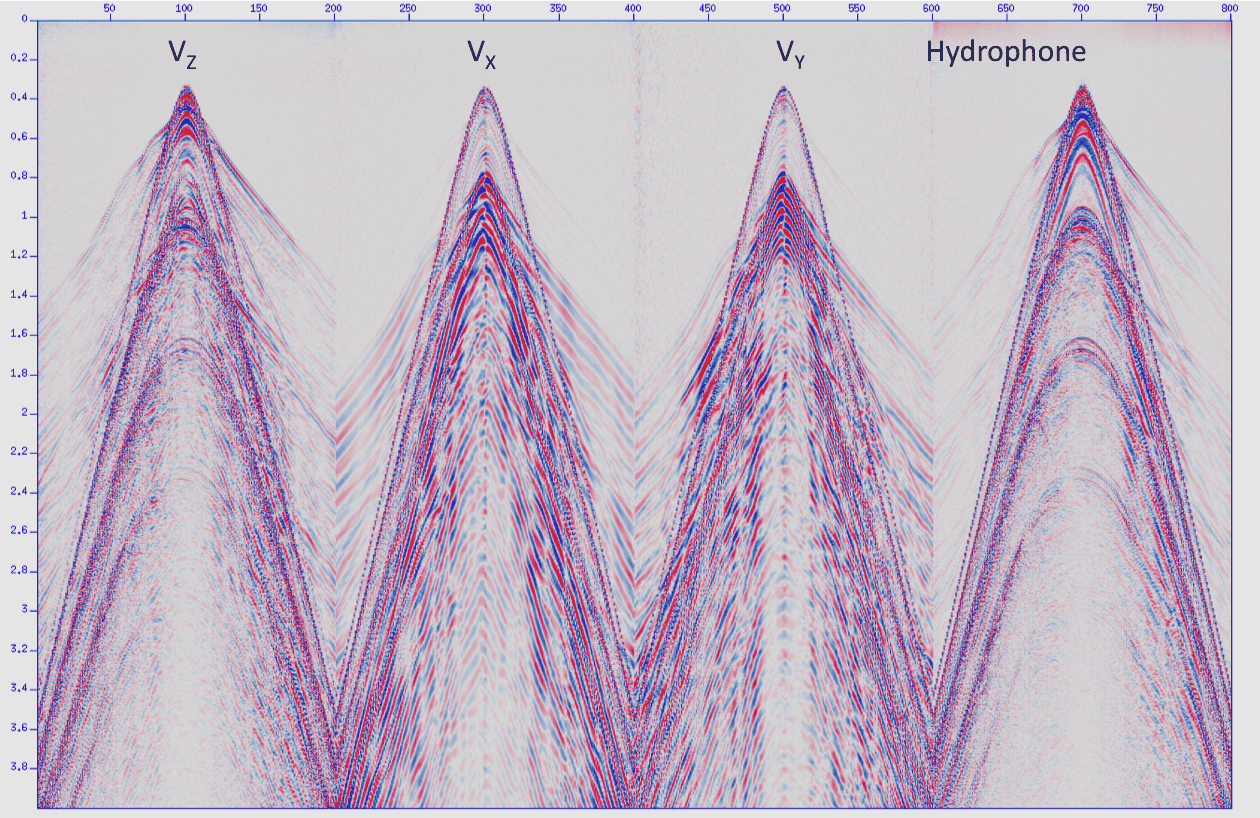
|
|---|
|
sufig1
Figure 1. Four component (4C) common receiver gather for a single shot line. [NR] |
|
|
The ultimate goal of our research is to develop a better way to image OBS data and to refine the art of processing OBS data. The most significant difference is that OBS data are multi-components: pressure P, and the three components, X, Y, Z, of the particle velocity or acceleration. Figure 1 shows a common receiver gather of a single shot line in a typical ocean bottom acquisition. From Figure 1, we can see that both pressure (P) and shear (S) waves are recorded. A natural approach is to use elastic modeling in the migration process. Indeed, Yan and Sava (2008) has proposed a way to perform isotropic elastic reverse time migration in the angle-domain. Such a scheme, although feasible, is still computationally expensive and the dependency on both P and S velocity model can be challenging.
At this stage, we focus on P wave imaging. The hydrophone records both up- and down-going pressure waves. The additional information from the OBS geophone's Z velocity measurement includes a polarity flip between up- and down-going waves. This enables separation of the up- and the down-going waves. Accounting for instrument gain, coupling to the seabed, and the fact that pressure is the acoustic impedance times the particle velocity, we can write:
| (1) |
Therefore, up- and down-going data at the receiver can be obtained as shown,
Equation 2 is often refered as PZ summation (White, 1965; Amundsen, 1993; Barr and Sanders, 1989). The advantage of turning P and Z data into up- and down-going data is that primary reflection events are contained solely in the up-going data. Therefore, a ``conventional'' migration can be performed on the cleaner up-going data. Recent work by Dash et al. (2009) suggested that the down-going waves should also be processed. Imaging the down-going waves is known as mirror imaging (Ebrom et al., 2000). We seek to incorporate the information in migrating with up-going data and migrating with down-going data by using a joint-inversion scheme as illustrated in Figure 2 and Figure 3.
After velocity analysis, migration is the process that estimates the earth reflectivity for given data and velocity model. With the velocity as the parameter space, migration is a linear operator (Figure 2(a)). Similarly, with the same parameter and model space, modeling is a linear operator (Figure 2(b)) and can be inverted. Figure 2(c) describes the concept of linear inversion. Migration and stacking is the adjoint of modeling. Sometimes the adjoint is a very good approximation to the inverse. Ideally, a good adjoint (migration) operator should be as close to the inverse of modeling as possible.
For single-component (acoustic) data, imaging with migration or with inversion are common. For multi-component ocean bottom data, applying the corresponding concept would require the use of elastic wave-equation either in migration or in inversion (Figure 2(d)). Elastic modeling is costly and the dependency on both P and S velocity models is problematic. On the other hand acoustic modeling is less costly and does not depend on shear velocity. We limit our ambition to acoustic waves and use hydrophone and vertical component of geophone measurements to image with both the primaries and the multiples signal. We illustrate this method in Figure 3. P and Z data can be converted into up- and down-going data with PZ summation, Equation 2. Up- and down-going data can be converted into over/under data, which are pressure waves sampled at two depth levels. Effectively, we can transform from P and Z data to up- and down-going data, and finally to over/under data. This allows us to perform inversion in the acoustic regime.
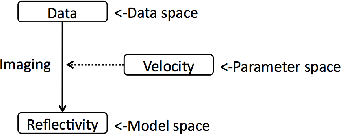
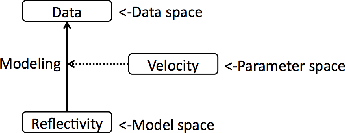
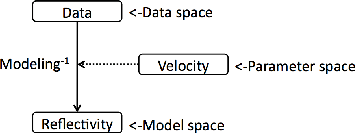
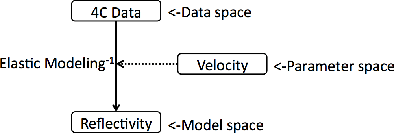
|
|---|
|
sufig8a,sufig8b,sufig8c,sufig8d
Figure 2. (a) The processing flow of imaging with reflectivity, also known as migration. (b) The flow of modelling, which creating synthetic data from reflecitivity and velocity. (c) The flow of inversion, which is linear if the model space is reflectivity and the velocity is in the parameter space. (d) The flow of elastic inversion. [NR] |
|
|
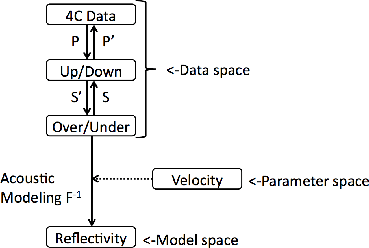
|
|---|
|
sufig9
Figure 3. Acoustic inversion of multi-component data using only the P waves. Pre-processing of the 4C data to over/under enables us to use acoustic- instead of elastic-modeling. [NR] |
|
|
It is worth mentioning that our joint inversion scheme can be applied to the processing of dual-sensor streamer data. The P and Z measurements of dual-sensor data can be conveniently combined to produce up- and down-going data using PZ summation and subsequently be used for joint-inversion imaging. The two advantages with this procedure for dual sensor data are (1) the repairing of attenuated signal at the notch frequencies and (2) the improved image from the additional information provided by the mirror signal (receiver ghost).
This is a progress report to apply joint inversion of up- and down-signal described in Wong et al. (2009). We apply reverse time migration to synthetic ocean bottom data to compare the migration result using either the up-going or the down-going signal. While OBS measure the pressure and shear waves, we limit our synthetic study to acoustic data only. To avoid using elastic modeling to synthesize multi-component ocean bottom data, we generate acoustic up- and down-going ocean bottom recording in two steps. First, two-way acoustic wave-equation is used to generate data at two different depths level, called the over/under data, near the seabed. Then an up-down separation operator,  , is applied to produce our desired up- and down-going ocean bottom data.
, is applied to produce our desired up- and down-going ocean bottom data.
We found that while migrating the up-going data gives strong reflector amplitudes and weak artifacts, its area of sub-surface illumination is narrower than migrating with down-going signal. We also found that there are additional RTM artifacts because of the recorded waves injection at the ocean bottom. This new class of artifacts does not exist with the traditional streamer geometry.
The rest of the paper is organized as follows. We first explain our method of constructing the RTM operator and the up-down separation operator. Next, we present the results of migrating with the up-going wave only, down-going wave only, and the total signal. A discussion on the types of artifacts follows. Finally, we propose a way to eliminate ocean bottom RTM artifacts, as well as combining up- and down-going migration results using joint inversion, which will be the focus of future research.
|
|
|
|
Reverse Time Migration of up and down going signal for ocean bottom data |